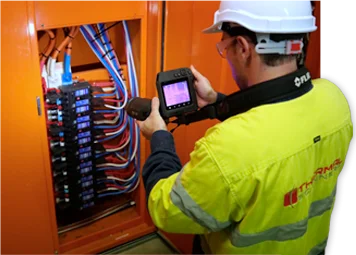What are the benefits of thermal imaging?
Thermal thermal scan can detect heat sources, even in complete darkness or through
smoke and fog. This makes it valuable for security applications, as it can
identify intruders or potential fire hazards when traditional cameras might
fail.
Building
Inspections:
In the construction and building maintenance
industries, thermal imaging is used to identify structural issues, such as
water leaks, insulation problems, and electrical faults. This early detection
can prevent costly damage and improve energy efficiency.
Electrical
Inspections:
Thermal imaging is highly eff
ective for
identifying electrical problems in a non-contact manner. It can pinpoint
overheating components, loose connections, and overloaded circuits, preventing
electrical fires and equipment failures.
Mechanical
Inspections:
In industrial settings, thermal imaging is used
to monitor the condition of machinery and equipment. By identifying overheating
parts, maintenance teams can perform timely repairs, reducing downtime and
extending the lifespan of assets.
Energy
Efficiency:
Thermal imaging helps identify areas of heat
loss or excessive heat in buildings. This information is invaluable for
optimizing heating, ventilation, and air conditioning (HVAC) systems, reducing
energy consumption, and lowering utility costs.
Search
and Rescue:
Thermal imaging is an essential tool for search
and rescue operations, as it can detect body heat and identify individuals in
challenging environments, such as dense forests, snowstorms, or collapsed
buildings.
Wildlife
Conservation:
Biologists and conservationists use thermal
imaging to study animal behavior and monitor wildlife populations. It helps
track animal movements and nesting activities, even in remote or nocturnal
settings.
Medical
Applications:
In the medical field, thermal imaging can be
used for various purposes, including detecting and diagnosing medical
conditions. It is non-invasive and can identify temperature variations that may
indicate inflammation, circulation issues, or tissue abnormalities.
Firefighting:
Firefighters use thermal imaging cameras to
navigate through smoke-filled environments and locate people or hotspots within
burning structures. This technology enhances situational awareness and safety during
firefighting operations.
Predictive
Maintenance:
Thermal imaging is a valuable tool
for implementing predictive maintenance programs in various industries. By
regularly monitoring equipment and identifying temperature anomalies,
maintenance can be scheduled before a failure occurs, reducing downtime and
costs.
Quality
Control:
In manufacturing and production, thermal imaging
is used for quality control. It can identify defects, inconsistencies, and
overheating in products, ensuring that only high-quality items reach the
market.
Thermal Scanners offers a diverse range of
benefits across numerous industries and applications. Its ability to detect
temperature variations and visualize heat sources makes it a valuable tool for
enhancing safety, improving efficiency, preventing damage, and advancing
research in various fields. As technology continues to evolve, the applications
of thermal imaging are likely to expand, further contributing to our understanding
of the world around us and improving our quality of life.



Comments
Post a Comment